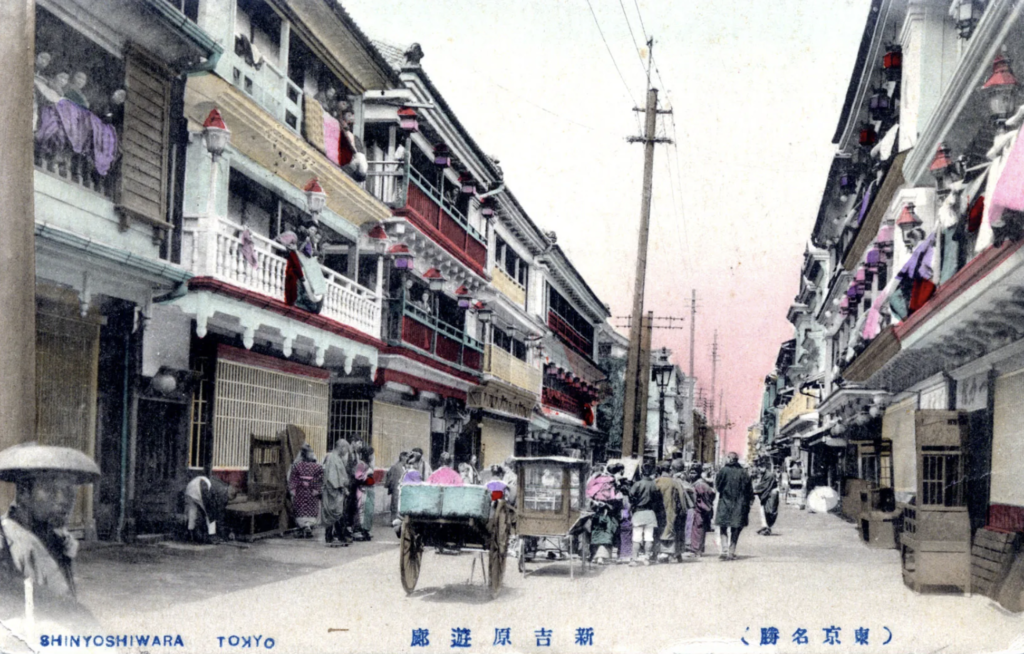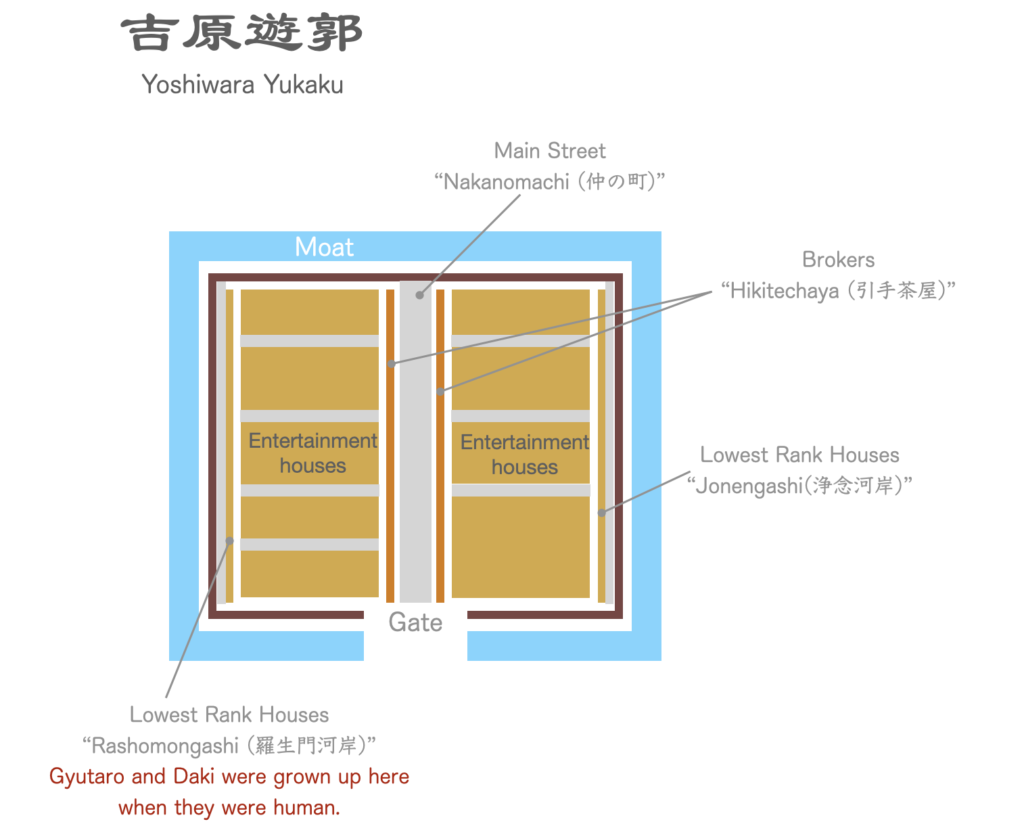The Entertainment District Arc is the third arc of Demon Slayer: Kimetsu no Yaiba, after the Tanjiro Unwavering Resolve Arc and the Mugen Train Arc. What place do you imagine, when you hear the word “Entertainment District”? To give an example in the current world, it could be similar to The Red Light District (De Wallen) in Amsterdam in the Netherlands, but it was a bit different.
>know the Entertainment District of Japan which existed as the center of the culture
>read the Taisho Secret of the Upper Six demon Gyutaro and Daki
The Entertainment District “Yukaku”
About the Entertainment District in Japan

In Japan The Entertainment Districts which were officially acknowledged by the government existed from 1617 to 1956, until it was completely prohibited by the law. The Entertainment District was the place where gorgeously dressed women entertained men. The Sound Hashira Tengen Uzui expresses it as “the most flamboyant place in all of Japan, filled with lust and greed (Demon Slayer: Kimetsu no Yaiba, Comic 9, Chapter 70)”.
The Entertainment District was called “Yukaku (遊郭)“. “Yoshiwara Yukaku (吉原遊郭)” in Tokyo, “Shimabara Yukaku (島原遊郭)” in Kyoto, and “Shinmachi Yukaku (新町遊郭)” in Osaka were the three largest Entertainment Districts in Japan.

This is the best place you can think of for the mission of Tengen Uzui, who loves flamboyant and flashy!
Why was the Entertainment District walled?
In Japanese language the Entertainment District is called “Yukaku (遊郭)“, which means “walled place to enjoy”. In fact the Entertainment Districts were literally walled places, and usually there was only one gate. There are two reasons for this:
- In order to maintain peace and order
On one side of the gate there were always guards who prevented criminals or suspicious people from entering the district. - In order to prevent female prostitutes from escaping
On the other side of the gate, there was a counter where the ticket for women was issued to control the traffic of women. Not all of the women in the Entertainment District were happy working in the Entertainment District and they sometimes disguised themselves as men and tried to get out of the district.
The Yoshiwara Yukaku
The story of the Entertainment District Arc is set in the Yoshiwara Yukaku (吉原遊郭). The Yoshiwara Yukaku actually existed in Tokyo. In the Edo era (1603〜1868) the population in the capital city, namely Tokyo, was increasing rapidly. Many people came to Tokyo to find a job and there were female prostitutes everywhere to entertain them. In order to maintain public morals and order, it was preferable to collect women in one place and allow the business. The Edo Shogunate approved it and the Yoshiwara Yukaku was built. During the Edo era, the Entertainment District was open only during the day and it was only for Samurai or wealthy merchants. The district became the center of culture with gorgeous dressing and top cuisine.
The city continued growing and the Yoshiwara Yukaku became too close to the city center. The government saw it as a problem and decided to move the district to the north of Sensoji Temple (浅草寺) which still exists in Asakusa (浅草), Tokyo. “New Yoshiwara Yukaku (新吉原遊郭)” was built. “Yoshiwara Yukaku” which appears in Demon Slayer is New Yoshiwara Yukaku. As the district became far from the center and it became inconvenient, the Edo Shogunate allowed business in the night time as well. From this time the Yukaku became popular among the ordinary citizens.
New Yoshiwara Yukaku was a walled district following the custom. Outside of the wall there was also a moat which made the escape even more difficult. The area was approximately 330m x 250m and more than 10,000 people lived in the district.

Ranks of Woman
The women working in the Entertainment District had to entertain men from high social classes. It means that they had to be highly cultured and educated. In their free time they practiced composing poems, playing music instruments, painting and the Japanese tea ceremony.
The Entertainment District was a hierarchical society and women working in Yoshiwara Yukaku had different ranks. The women of higher rank were not only beautiful but also had many skills. Women with higher rank got higher fees.

The top prostitutes were called “Oiran (花魁)“. When an Oiran was called, she went to greet her customer accompanied by many staff. This was called an “Oiran Dochu (花魁道中)” meaning “Oiran Parade”. It was difficult for ordinary people to meet the top class Oiran. So they went to Yukaku very often hoping to just have a look at Oiran.
Oiran was famous not only in Yukaku district but also among general public. In the Edo era the art called “Ukiyo-e (浮世絵)” flourished. The Ukiyo-e artists produced paintings of landscapes, Sumo wrestlers and Oiran. Through the arts Oiran became known among general public and women imitated the hair style. Oiran were namely fashion leaders as well.

Oiran – the other face of the Upper Six Demon Daki
The Upper Six Demon Daki (堕姫) pretended to be an Oiran for a long time. She is called “Warabihime Oiran (蕨姫花魁)” when she appears in the story. Every 10 years or so she changed her face and name and worked in different entertainment houses. Daki was so beautiful that some men faint by just looking at her. Without doubt she was the most selling Oiran of Yoshiwara Yukaku (Reference: Demon Slayer: Kimetsu no Yaiba Fan Book Vol.1).
Women who “lose their footing”
There were many women who were sold due to poverty and were not treated well, especially those in lower ranks. These women sometimes “lost their footing”, meaning that they disappeared or escaped. In Japanese language it was particularly called Ashinuke (足抜け). When a woman was eaten by Gyutaro and Daki, people thought that she just escaped from the district. The Yukaku was a very convenient place for demons to live.
Tout and Debt Collector “Gyu”
There were different jobs inside the Entertainment District. One of them is “Gyu (妓夫)” , which the name of the Upper Six Demon “Gyutaro (妓夫太郎)” is based on. Gyu is a tout who measures visitors’ capacity to pay. Visits to the Entertainment District cost a lot. Three visits to an intermediate class woman easily cost JPY 200,000 (USD 1,500) converted to the current value. There were some people who went beyond their payment capacity. Gyu was collecting debt from those people. When Daki’s head was sliced by Tengen Uzui, Gyutaro says:
Time to collect the debts. I’ll collect one for every bruise they put on you.
Demon Slayer: Kimetsu no Yaiba, Comic 10, Chapter 86
”Time to collect the debts” – that’s probably his line since the time when he was still a human.
Taisho Secret of Gyutaro and Daki
Upper Two demon Doma (童磨) invited Gyutaro and Daki to become demons. Doma “saved” Daki when she was burnt due to the fact that she pricked the eye of a Samurai warrior when he visited her as a customer. The reason why Daki pricked the eye of the Samurai is not described in the comic nor in the anime. It was because he insulted her beloved brother Gyutaro. (Reference: Demon Slayer: Kimetsu no Yaiba Fan Book Vol.2)
Facts which should not be forgotten
The Entertainment District “Yukaku” was a flamboyant place and center of the culture. But we should not forget that many women who were living there had tough lives and many of them could not live long. When they died, they were brought to so-called Nagekomidera “投げ込み寺” meaning “Throw-in Temple” where bodies of people without family are taken care of. Jokanji Temple “浄閑寺” is one of the most famous Throw-in Temples for the women from Yoshiwara Yukaku.

Have you enjoyed learning the facts on the Japanese Entertainment Districts which really existed?






